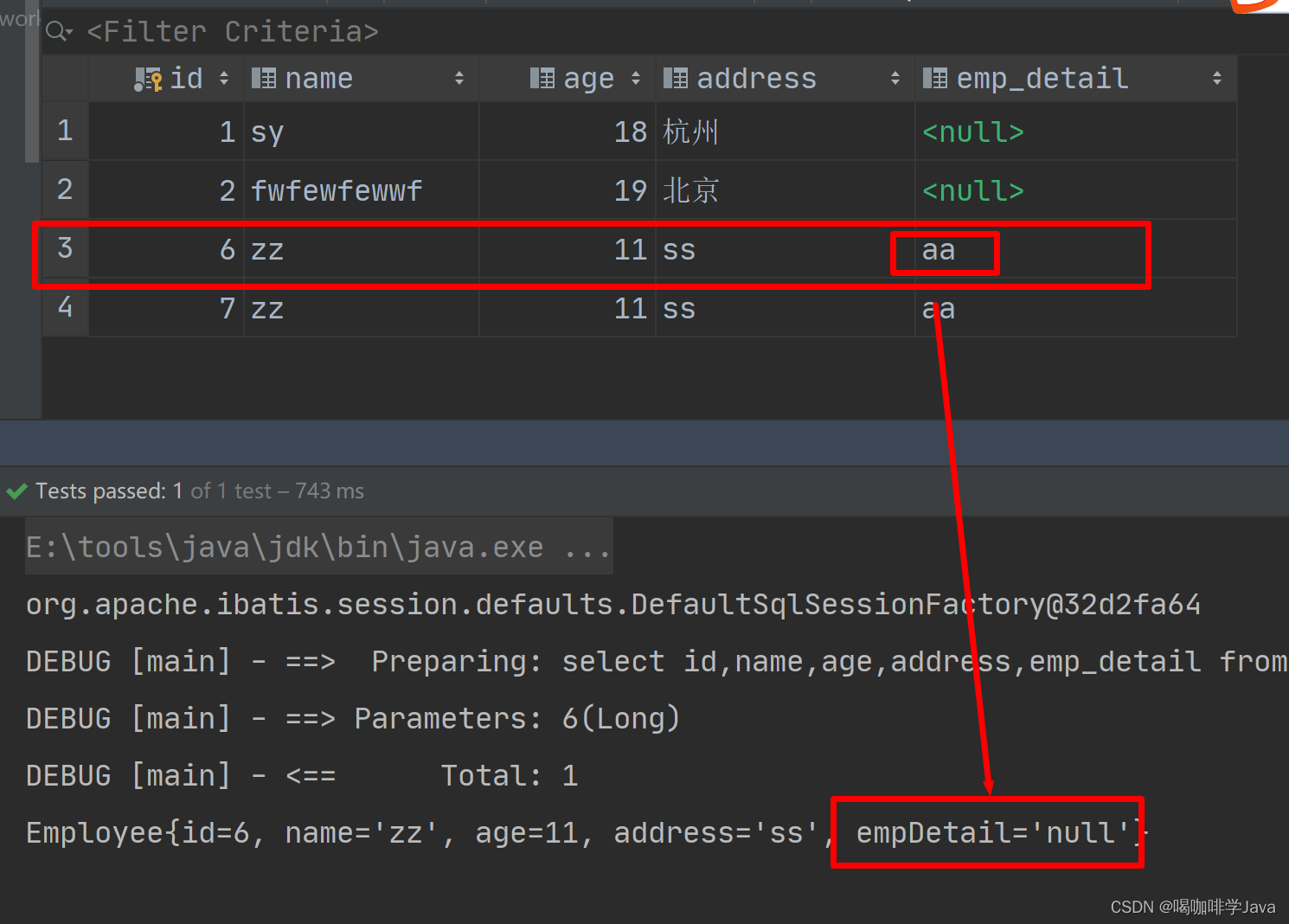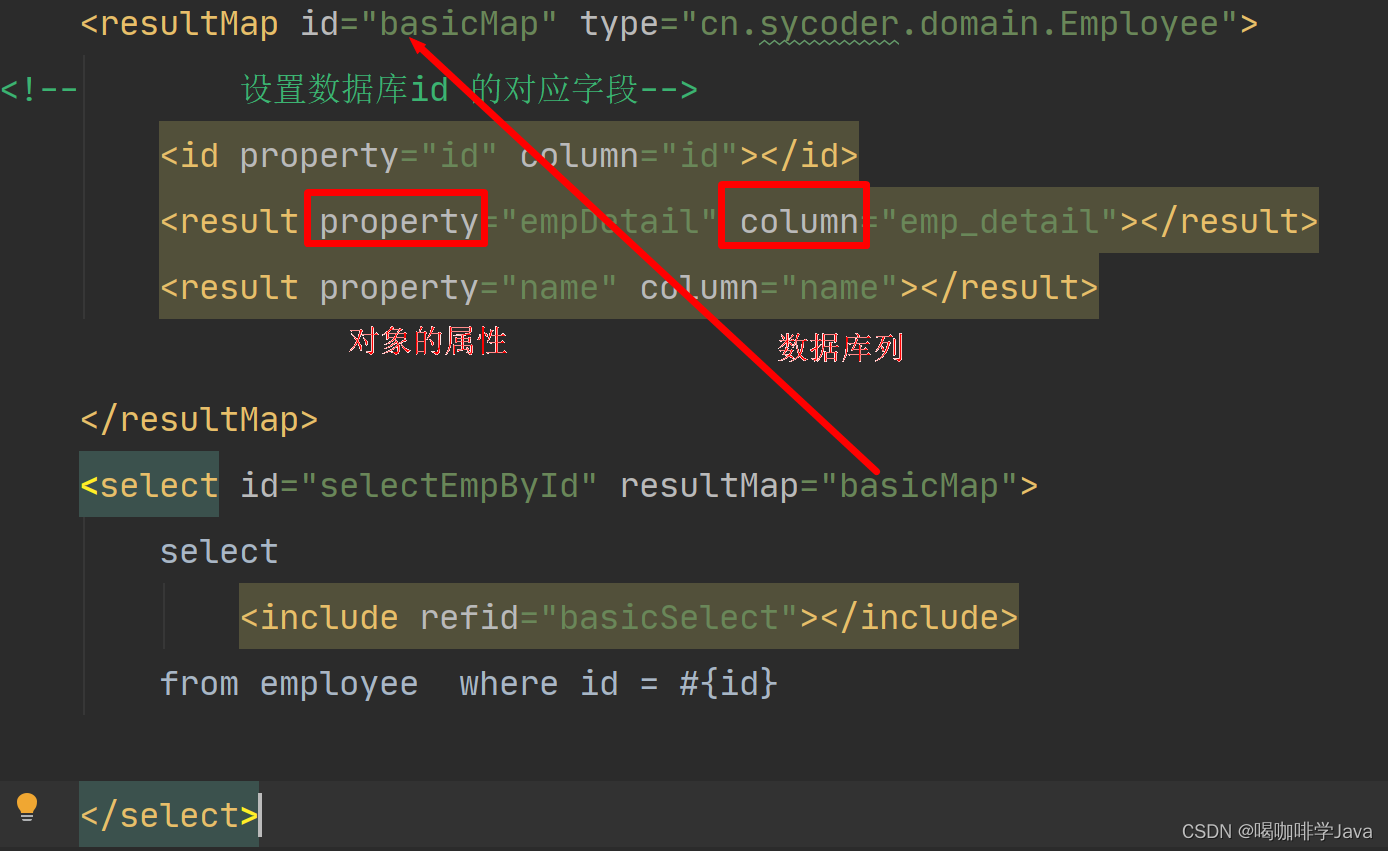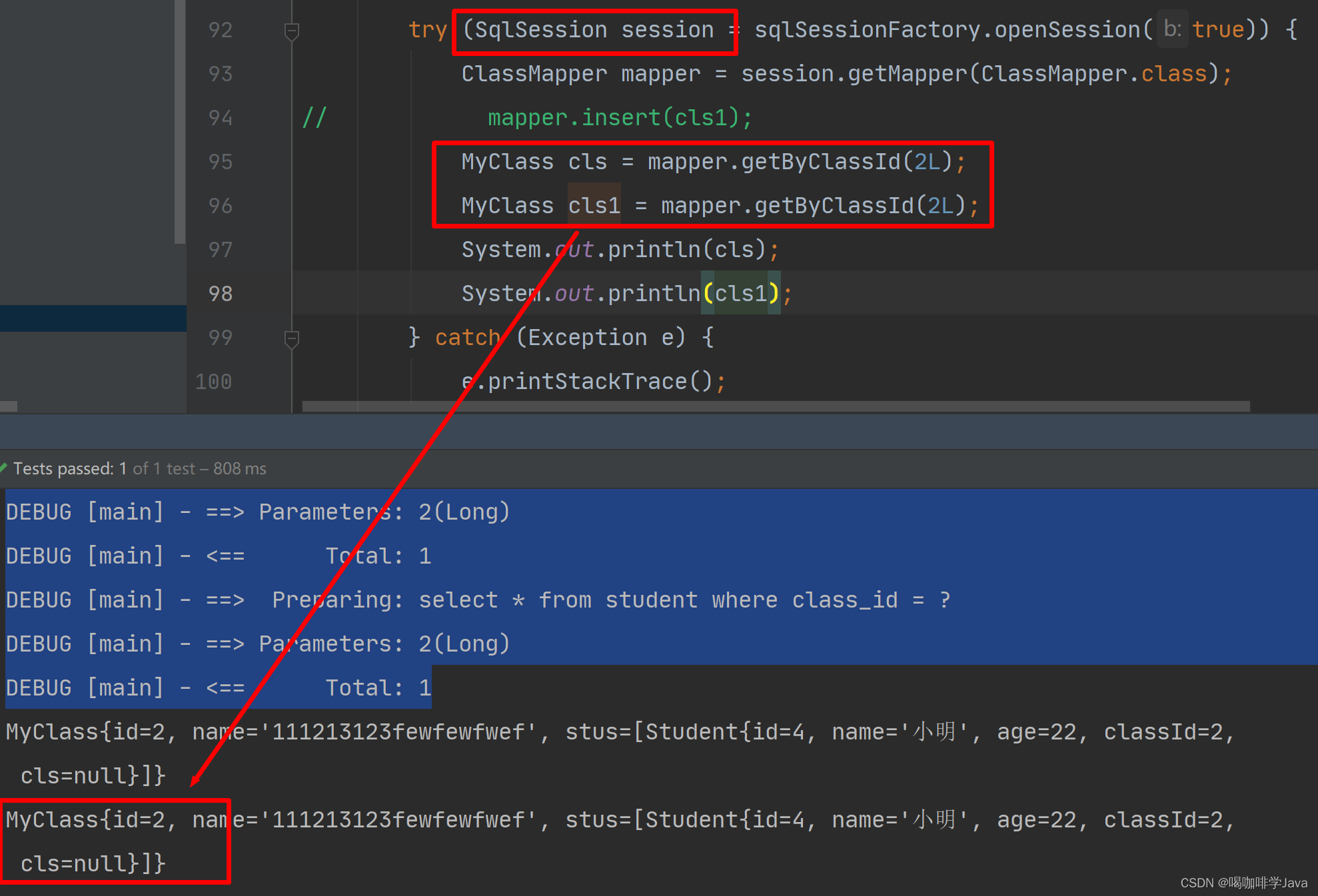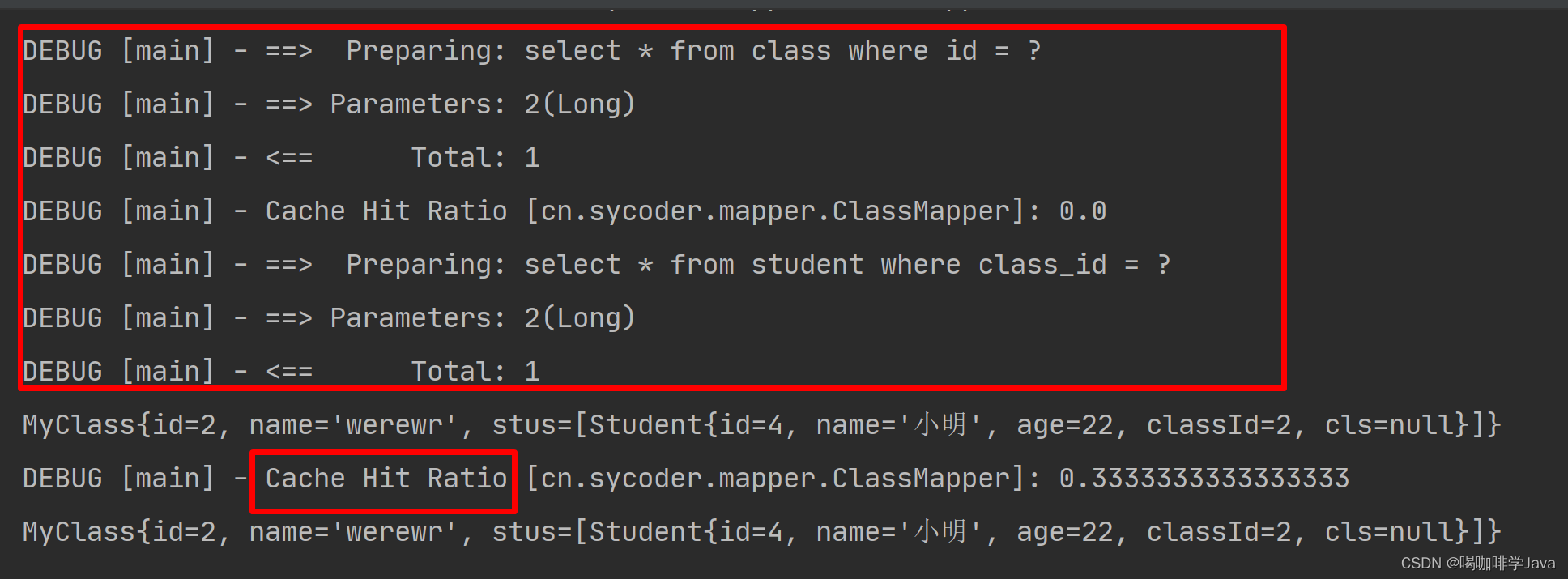MyBatis-XML映射文件详解

一、XML 映射器
1.概述
使用 xml 文件去配置 SQL 代码,比传统的 jdbc 简单方便,能够少写代码,减少使用成本,提高工作效率。
1.1SQL 映射文件中的顶级元素
cache – 该命名空间的缓存配置。
cache-ref – 引用其它命名空间的缓存配置。
resultMap – 描述如何从数据库结果集中加载对象,是最复杂也是最强大的元素。
parameterMap – 老式风格的参数映射。此元素已被废弃,并可能在将来被移除!请使用行内参数映射。文档中不会介绍此元素。
sql – 可被其它语句引用的可重用语句块。
insert – 映射插入语句。
update – 映射更新语句。
delete – 映射删除语句。
select – 映射查询语句二、select
查询语句是 MyBatis 中最常用的元素之一
1.Select 元素的属性
| 属性 | 使用目的 | 描述 |
|---|---|---|
id |
和Mapper 接口方法名关联 | 在命名空间中唯一的标识符,可以被用来引用这条语句。 |
parameterType |
将会传入这条语句的参数的类全限定名或别名。这个属性是可选的,因为 MyBatis 可以通过类型处理器(TypeHandler)推断出具体传入语句的参数,默认值为未设置(unset)。 | |
| parameterMap | 用于引用外部 parameterMap 的属性,目前已被废弃。请使用行内参数映射和 parameterType 属性。 | |
resultType |
返回结果集 | 期望从这条语句中返回结果的类全限定名或别名。注意,如果返回的是集合,那应该设置为集合包含的类型,而不是集合本身的类型。resultType 和 resultMap 之间只能同时使用一个。 |
resultMap |
返回结果集 | 对外部 resultMap 的命名引用。结果映射是 MyBatis 最强大的特性,如果你对其理解透彻,许多复杂的映射问题都能迎刃而解。resultType 和 resultMap 之间只能同时使用一个。 |
flushCache |
将其设置为 true 后,只要语句被调用,都会导致本地缓存和二级缓存被清空,默认值:false。 | |
useCache |
用于开启缓存 | 将其设置为 true 后,将会导致本条语句的结果被二级缓存缓存起来,默认值:对 select 元素为 true。 |
timeout |
这个设置是在抛出异常之前,驱动程序等待数据库返回请求结果的秒数。默认值为未设置(unset)(依赖数据库驱动)。 | |
fetchSize |
这是一个给驱动的建议值,尝试让驱动程序每次批量返回的结果行数等于这个设置值。默认值为未设置(unset)(依赖驱动)。 | |
statementType |
默认值:PREPARED。 | 可选 STATEMENT,PREPARED 或 CALLABLE。这会让 MyBatis 分别使用 Statement,PreparedStatement 或 CallableStatement,默认值:PREPARED。 |
resultSetType |
FORWARD_ONLY,SCROLL_SENSITIVE, SCROLL_INSENSITIVE 或 DEFAULT(等价于 unset) 中的一个,默认值为 unset (依赖数据库驱动)。 | |
databaseId |
如果配置了数据库厂商标识(databaseIdProvider),MyBatis 会加载所有不带 databaseId 或匹配当前 databaseId 的语句;如果带和不带的语句都有,则不带的会被忽略。 | |
resultOrdered |
这个设置仅针对嵌套结果 select 语句:如果为true,则假设结果集以正确顺序(排序后)执行映射,当返回新的主结果行时,将不再发生对以前结果行的引用。 这样可以减少内存消耗。默认值:false。 |
|
resultSets |
适用于多结果集的情况 | 这个设置仅适用于多结果集的情况。它将列出语句执行后返回的结果集并赋予每个结果集一个名称,多个名称之间以逗号分隔。 |
2.常用设置
<selectid="selectPerson"resultType="hashmap"resultMap="personResultMap"timeout="10" #除非有特殊需求,否则不用>三、insert, update 和 delete
1.Insert, Update, Delete 元素的属性
| 属性 | 描述 | 是否使用 |
|---|---|---|
id |
在命名空间中唯一的标识符,可以被用来引用这条语句。 | 关联mapper 和 xml 语句 |
parameterType |
将会传入这条语句的参数的类全限定名或别名。这个属性是可选的,因为 MyBatis 可以通过类型处理器(TypeHandler)推断出具体传入语句的参数,默认值为未设置(unset)。 | |
parameterMap |
用于引用外部 parameterMap 的属性,目前已被废弃。请使用行内参数映射和 parameterType 属性。 | |
flushCache |
将其设置为 true 后,只要语句被调用,都会导致本地缓存和二级缓存被清空,默认值:(对 insert、update 和 delete 语句)true。 | 默认使用刷新缓存 |
timeout |
这个设置是在抛出异常之前,驱动程序等待数据库返回请求结果的秒数。默认值为未设置(unset)(依赖数据库驱动)。 | |
| `statementType | 可选 STATEMENT,PREPARED 或 CALLABLE。这会让 MyBatis 分别使用 Statement,PreparedStatement 或 CallableStatement,默认值:PREPARED。 | |
useGeneratedKeys |
(仅适用于 insert 和 update)这会令 MyBatis 使用 JDBC 的 getGeneratedKeys 方法来取出由数据库内部生成的主键(比如:像 MySQL 和 SQL Server 这样的关系型数据库管理系统的自动递增字段),默认值:false。 | 获取数据库生成的主键id |
keyProperty |
(仅适用于 insert 和 update)指定能够唯一识别对象的属性,MyBatis 会使用 getGeneratedKeys 的返回值或 insert 语句的 selectKey 子元素设置它的值,默认值:未设置(unset)。如果生成列不止一个,可以用逗号分隔多个属性名称。 |
keyProperty="id" |
keyColumn |
(仅适用于 insert 和 update)设置生成键值在表中的列名,在某些数据库(像 PostgreSQL)中,当主键列不是表中的第一列的时候,是必须设置的。如果生成列不止一个,可以用逗号分隔多个属性名称。 | |
databaseId |
如果配置了数据库厂商标识(databaseIdProvider),MyBatis 会加载所有不带 databaseId 或匹配当前 databaseId 的语句;如果带和不带的语句都有,则不带的会被忽略。 |
2.常用配置
<insert id="insertAuthor" useGeneratedKeys="true"keyProperty="id">insert into Author (username,password,email,bio)values (#{username},#{password},#{email},#{bio})
</insert>2.1 selectKey
| 属性 | 描述 | |
|---|---|---|
keyProperty |selectKey` 语句结果应该被设置到的目标属性。如果生成列不止一个,可以用逗号分隔多个属性名称。 |
||
keyColumn |
返回结果集中生成列属性的列名。如果生成列不止一个,可以用逗号分隔多个属性名称。 | |
| `resultType | 结果的类型。通常 MyBatis 可以推断出来,但是为了更加准确,写上也不会有什么问题。MyBatis 允许将任何简单类型用作主键的类型,包括字符串。如果生成列不止一个,则可以使用包含期望属性的 Object 或 Map。 | |
order |
可以设置为 BEFORE 或 AFTER。如果设置为 BEFORE,那么它首先会生成主键,设置 keyProperty 再执行插入语句。如果设置为AFTER,那么先执行插入语句,然后是selectKey` 中的语句 - 这和 Oracle数据库的行为相似,在插入语句内部可能有嵌入索引调用。 |
|
statementType |
和前面一样,MyBatis 支持 STATEMENT,PREPARED 和 CALLABLE 类型的映射语句,分别代表 Statement, PreparedStatement 和 CallableStatement 类型。 |
<selectKeykeyProperty="id"resultType="int"order="BEFORE"statementType="PREPARED">四、抽取共同sql
注意:mybatis spring 底层都会用到反射创建对象
1.作用:
sql:可以用来定义可重用的 SQL 代码片段
2.具体使用
<sql id="userColumns"> ${alias}.id,${alias}.username,${alias}.password </sql><select id="selectUsers" resultType="map">select<include refid="userColumns"><property name="alias" value="t1"/></include>,<include refid="userColumns"><property name="alias" value="t2"/></include>from some_table t1cross join some_table t2
</select><sql id="basicSelect">t1.id id,t1.name name,t1.age age,t1.address address</sql>
<select id="selectSql" resultType="cn.wjcoder.domain.Employee">select<include refid="basicSelect"></include>from employee t1 where t1.id = #{id}
</select>五、参数
1.#{参数名称}
1.1原理:
使用 #{}参数语法时,MyBatis 会创建 PreparedStatement参数占位符,并通过占位符安全地设置参数(就像使用 ? 一样

1.2特点:安全、快速、首选安全
2.${参数名称}
${参数名称} 会被直接替换,而 #{value} 会使用 ? 预处理
<select id="selectSql" resultType="cn.sycoder.domain.Employee">select<include refid="basicSelect"></include>from ${tableName} where id = #{id}
</select>Employee selectSql(@Param("tableName") String tableName,@Param("id") Long id);
2.1特点:可以做表名拼接,更加方便灵活
2.2面试题:说说 mybatis # 取参和 $ 取参的区别
-
${参数名称}会被直接替换,而#{value}会使用?预处理
2.3补充:使用 @Param 底层自动给我们转换成一个 map 来传参的
六、结果映射
1.ResultType 映射
1.1使用 resultType查询单个Map对象
<select id="selectMap" resultType="map">select * from employee where id = #{id}
</select>Map selectMap(Long id);1.2使用 resultType查询查询具体单个对象
<select id="select" resultType="cn.wjcoder.domain.Employee">select * from employee where id = #{id}
</select>Employee select(@Param("id") Long id);1.3查询集合对象
<select id="selectList" resultType="cn.wjcoder.domain.Employee">select * from employee where id = #{id}
</select>List<Employee> selectList(Long id);1.4查询单个值
<select id="selectCount" resultType="java.lang.Integer">select count(*) from employee
</select>Integer selectCount();2.ResultMap 映射
2.1使用ResultType 问题
单独使用ResultType 会出现如下问题

2.2ResultMap
应用场景:实体类属性和数据库列名不匹配的时候(比如,数据库采用经典命名法,java 使用驼峰命名法的时候)
<resultMap id="basicMap" type="cn.wjcoder.domain.Employee"><!-- 设置数据库id 的对应字段--><id property="id" column="id"></id><result property="empDetail" column="emp_detail"></result><result property="name" column="name"></result></resultMap><select id="selectEmpById" resultMap="basicMap">select * from employee where id = #{id}</select>
解决方式2
<settings><setting name="mapUnderscoreToCamelCase" value="true"/></settings>id & result
<id property="id" column="post_id"/>
<result property="subject" column="post_subject"/>id & result 属性
| 属性 | 描述 | |
|---|---|---|
property |
映射到列结果的字段或属性。如果 JavaBean 有这个名字的属性(property),会先使用该属性。否则 MyBatis 将会寻找给定名称的字段(field)。无论是哪一种情形,你都可以使用常见的点式分隔形式进行复杂属性导航。 比如,你可以这样映射一些简单的东西:“username”,或者映射到一些复杂的东西上:“address.street.number”。 stu.name | |
column |
数据库中的列名,或者是列的别名。一般情况下,这和传递给 resultSet.getString(columnName) 方法的参数一样。 |
|
javaType |
一个 Java 类的全限定名,或一个类型别名(关于内置的类型别名,可以参考上面的表格)。 如果你映射到一个 JavaBean,MyBatis 通常可以推断类型。然而,如果你映射到的是 HashMap,那么你应该明确地指定 javaType 来保证行为与期望的相一致。 |
2.3多结果集处理前期准备
新建学生和班级表
create table class
(id bigint auto_incrementprimary key,name varchar(64) null
);create table student
(id bigint auto_incrementprimary key,name varchar(64) null,age int null,class_id bigint null,constraint student_class_id_fkforeign key (class_id) references class (id)
);insert into class values (null,'软工1班'),(null,'计科2班');insert into student (id, name, age,class_id)
values (null,'sy',18,1),(null,'zs',19,1),(null,'zz',20,1),(null,'小明',22,2);2.4一对多处理
一对多查询:查询某班学生信息
collection :使用 collection 就可以获取到多个结果集对象
- 第一步,新建 mapper 方法
public interface ClassMapper {MyClass getById(Long id);
}- 第二步,编写 xml
<?xml version="1.0" encoding="UTF-8" ?>
<!DOCTYPE mapperPUBLIC "-//mybatis.org//DTD Mapper 3.0//EN""https://mybatis.org/dtd/mybatis-3-mapper.dtd">
<mapper namespace="cn.wjcoder.mapper.ClassMapper"><resultMap id="basicMap" type="cn.wjcoder.domain.MyClass"><id property="id" column="id"></id><result property="name" column="name"></result>
<!-- 获取学生信息信息--><collection property="stus" ofType="cn.wjcoder.domain.Student"><id property="id" column="sId"></id><result property="name" column="sName"></result><result property="age" column="age"></result><result property="classId" column="class_id"></result></collection></resultMap><select id="getById" resultMap="basicMap">selectc.*,s.id sId,s.name sName,s.age,s.class_idfromclass c left join student s on c.id = s.class_idwhere c.id = #{id}</select>
</mapper>
2.5多对一的处理
多对一查询:查询每个学生所在班级信息
关联(association):如果我的类里面有其它对象的关联关系,可以使用 association 来进行操作
| 属性 | 描述 |
|---|---|
property |
映射到列结果的字段或属性。如果用来匹配的 JavaBean存在给定名字的属性,那么它将会被使用。否则 MyBatis 将会寻找给定名称的字段。无论是哪一种情形,你都可以使用通常的点式分隔形式进行复杂属性导航。比如,你可以这样映射一些简单的东西:“username”,或者映射到一些复杂的东西上:“address.street.number”。 |
javaType |
一个 Java 类的完全限定名,或一个类型别名(关于内置的类型别名,可以参考上面的表格)。 如果你映射到一个 JavaBean,MyBatis 通常可以推断类型。然而,如果你映射到的是HashMap,那么你应该明确地指定 javaType 来保证行为与期望的相一致。 |
- 传统操作(使用级联操作 )
<resultMap id="basicMap" type="cn.wjcoder.domain.Student"><id property="id" column="id"></id><result property="name" column="name"></result><result property="age" column="age"></result><result property="classId" column="class_id"></result><result property="cls.id" column="cId"></result><result property="cls.name" column="cName"></result></resultMap><select id="listAllStus" resultMap="basicMap">selectstu.*,c.id cId,c.name cNamefromstudent stu left join class c on stu.class_id = c.id</select>- 使用 association 操作
<resultMap id="AssociationMap" type="cn.wjcoder.domain.Student"><id property="id" column="id"></id><result property="name" column="name"></result><result property="age" column="age"></result><result property="classId" column="class_id"></result><association property="cls" javaType="cn.sycoder.domain.MyClass"><id property="id" column="cId"></id><result property="name" column="cName"></result></association></resultMap><select id="listAllStusByAssociation" resultMap="AssociationMap">selectstu.*,c.id cId,c.name cNamefromstudent stu left join class c on stu.class_id = c.id</select>
3.嵌套 select 查询
3.1关联关系 assciation select
- 查询学生信息,包含班级信息
<resultMap id="AssociationSelectMap" type="cn.wjcoder.domain.Student"><id property="id" column="id"></id><result property="name" column="name"></result><result property="age" column="age"></result><result property="classId" column="class_id"></result><association property="cls" column="class_id"select="cn.wjcoder.mapper.StudentMapper.getClassById"/>
</resultMap>
<select id="listAllStusByAssociationSelect" resultMap="AssociationSelectMap">select * from student
</select><select id="getClassById" resultType="cn.wjcoder.domain.MyClass">select * from class where id = #{id}
</select>
- 如果关联的是多个结果集使用 resultSet
| 属性 | 描述 |
|---|---|
column |
当使用多个结果集时,该属性指定结果集中用于与 foreignColumn 匹配的列(多个列名以逗号隔开),以识别关系中的父类型与子类型。 |
foreignColumn |
指定外键对应的列名,指定的列将与父类型中 column 的给出的列进行匹配。 |
resultSet |
指定用于加载复杂类型的结果集名字。 |
<resultMap id="blogResult" type="Blog"><id property="id" column="id" /><result property="title" column="title"/><association property="author" javaType="Author" resultSet="authors" column="author_id" foreignColumn="id"><id property="id" column="id"/><result property="username" column="username"/><result property="password" column="password"/><result property="email" column="email"/><result property="bio" column="bio"/></association>
</resultMap>3.2 collection select
- 需求:通过班级去查学生,使用嵌套 select 查询
<resultMap id="collectionSelect" type="cn.wjcoder.domain.MyClass"><id property="id" column="id"></id><result property="name" column="name"></result><!-- 获取学生信息信息--><collection property="stus" ofType="cn.wjcoder.domain.Student"select="getStudentByClassId" column="id"/></resultMap><select id="getByClassId" resultMap="collectionSelect">select * from class where id = #{id}
</select>
<select id="getStudentByClassId" resultType="cn.wjcoder.domain.Student">select * from student where class_id = #{id}
</select>
3.3 关联查询的总结
- 有点:
-
可以实现延迟加载,前提是要配置
-
sql 写起来变得简单了
-
- 缺点:发起了多条 sql,正常查询只发起一条sql
七、自动映射
- 自动映射:将列名和结果集关联。
<select id="selectUsers" resultMap="userResultMap">selectuser_id as "id",user_name as "userName",hashed_passwordfrom some_tablewhere id = #{id}
</select><resultMap id="userResultMap" type="User"><result property="password" column="hashed_password"/>
</resultMap>-
可以全局配置将经典的列名转换成驼峰的方式
-
映射等级分类
-
NONE- 禁用自动映射。仅对手动映射的属性进行映射。 -
PARTIAL- 对除在内部定义了嵌套结果映射(也就是连接的属性)以外的属性进行映射 -
FULL- 自动映射所有属性。
-
八、缓存
1.概述
Mybatis 缓存:MyBatis 内置了一个强大的事务性查询缓存机制,它可以非常方便地配置和定制。
2.会话缓存(一级缓存)
sqlSession 级别的,也就是说,使用同一个 sqlSession 查询同一 sql 时,直接从缓存数据中取,不需要操作数据库。

-
失效情况
-
同一个 sqlSession 条件不同
-
同一个 sqlSession 执行期间执行了增加、删除、修改操作
-
手动清缓存
-
3.二级缓存
-
使用之前必须在mapper.xml 文件中添加 <cache/>
-
二级缓存:是 sqlSessionFactory 级别的,只要使用同一个 sqlSessionFactory 创建的 sqlSession 查询同一 sql 都可以使用缓存
-
使用前注意:
-
先再 mapper.xml 中手动开启二级缓存
-

-
失效情况
-
必须给类实现序列化接口(其实原理就是把对象信息写进一个序列化文件中,通过对象流)
-
两次查询之间添加了任何的增删改操作
-
insert、update 和 delete 语句会刷新缓存
-
-
二级缓存清除策略
-
LRU– (Least Recently Used)最近最少使用:移除最长时间不被使用的对象。默认使用方式 -
FIFO– 先进先出:按对象进入缓存的顺序来移除它们。 -
SOFT– 软引用:基于垃圾回收器状态和软引用规则移除对象。 -
WEAK– 弱引用:更积极地基于垃圾收集器状态和弱引用规则移除对象。
-
<cacheeviction="FIFO"flushInterval="60000"size="512"readOnly="true"/>-
flushInterval:刷新间隔,单位毫秒
-
size:引用数目,默认是1024
-
readOnly:只读操作默认是 false
-
true,会给调用的地方返回相同实例,对象不能修改
-
false:可以修改,返回实例的拷贝
-
4.缓存查询顺序
-
先查二级缓存,范围比较大,可能有其它会话缓存的信息
-
再查一级缓存
-
再查数据库
-
如果sqlSession关闭会把一级缓存信息缓存到二级缓存


